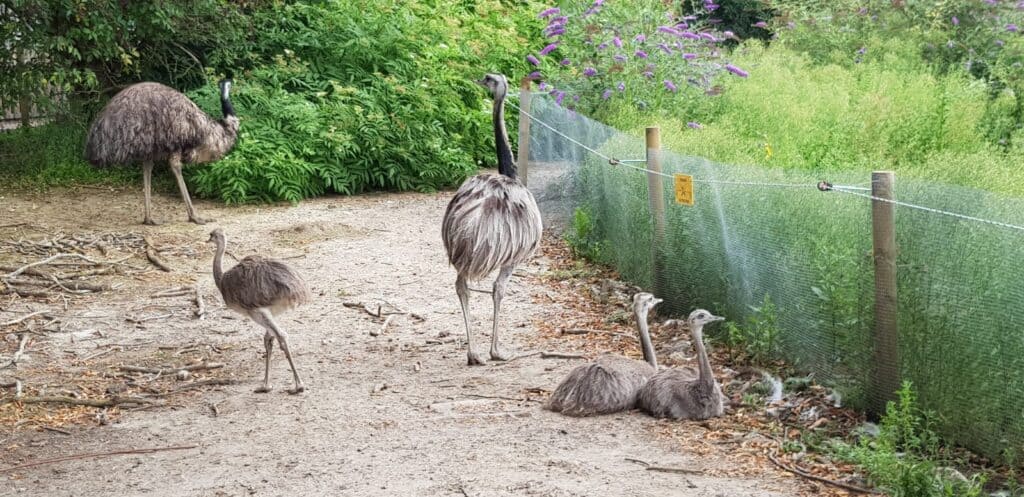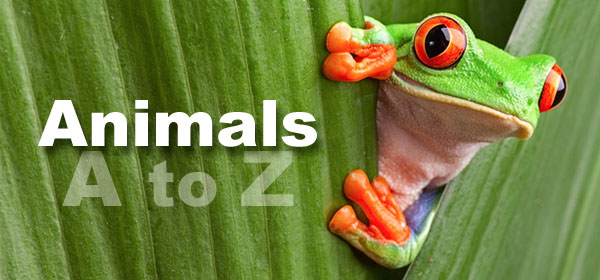When I was younger, I was quite into Jurassic Park and dinosaurs! Maybe that is where some of my bird enthusiasm comes from, as after all, we now know that birds are descended from dinosaurs! No other group of birds here at the park remind me of this more than our group of rheas! This group of birds are large flightless birds in their own order, the “Rheiformes” and are native to South America. There are currently two recognised species of rhea: the greater rhea and the lesser rhea (aka Darwin’s rhea). Some authorities claim that there is a third species known as the Puna rhea, but this requires further research.
Here at Wingham Wildlife Park, we currently have five greater rheas (Rhea americana). Our male Caesar, who has darker patches on his upper back and neck compared to our female Shakira and we were thrilled to watch three youngsters hatch and grow here at the park this year. These prehistoric-looking birds stand at around 1.5 m tall and once roamed freely across the grasslands and open savannas of Brazil, Argentina, Paraguay, Bolivia, and Uruguay. Weighing in at around 30 kilograms, the rhea is South America’s largest bird, yet despite its size, this impressive bird is now facing a troubling decline across its range.

According to the IUCN Red List, the greater rhea is currently classified as Near Threatened, with its population decreasing due to ongoing threats. In terms of lifespan, wild greater rheas typically live 10 to 15 years, though individuals in captivity can reach up to 30 years. In their natural habitat, however, they face a plethora of threats including habitat loss from the conversion of grasslands into agricultural land and direct persecution. Rheas are often viewed by farmers as pests, particularly when they venture into crop fields. Additionally, illegal hunting for their meat, skin and eggs still occurs in some regions despite protective laws. In many regions, especially in Brazil and Argentina, expanding farmland has fragmented the rhea’s natural habitat, forcing it into smaller, more isolated areas where survival becomes increasingly difficult. Their feathers are often used to make feather dusters and the illegal pet trade is also a problem.
Adding to the conservation challenge is the fact that rheas require large, continuous tracts of land to thrive in the wild. Fragmentation caused by fences, roads, and monoculture plantations break up their habitat and limit their ability to roam and find mates. This isolation can lead to inbreeding and reduced genetic diversity in smaller populations. Conservationists have called for stronger habitat protection, wildlife corridors and community education to reduce human-wildlife conflict and support rhea-friendly land use practices.
Although still relatively widespread across South America, population numbers have been steadily falling. In some parts of its range, particularly in the South, the greater rhea has become rare or even locally extinct. These pressures have raised concerns about the species’ long-term viability. Interestingly though, a small feral population of greater rheas has taken hold in an unexpected location in northern Germany. Originally escapees from a private collection in the early 2000s, these birds have adapted remarkably well to European grasslands, forming a self-sustaining wild population. While controversial among local farmers, it’s a surprising testament to the species’ resilience and adaptability when given space and protection.
I found myself thinking about the plight of these magnificent birds when we discovered we had had three babies at the beginning of June. For me, one of the most fascinating aspects of greater rhea biology is their unusual breeding system. Unlike many birds, it’s actually the male who takes full responsibility for raising the young. Although they are sociable and form groups of around 30, during the breeding season males tend to be solitary and will establish a nesting territory, fighting with other males for dominance, before mating with several females. The females will also form smaller groups and the males will show off to the females by making deep calls and displaying their wings. Each female lays her eggs in the same ground nest, contributing to a shared clutch that can include anywhere from 10 to over 60 eggs. Caesar did such a good job at incubating Shakira’s eggs, it was fascinating to watch this behaviour first hand!

After the females lay their eggs, they leave the nest leaving the male to take care of the chicks. He incubates the eggs for about six weeks and once the chicks hatch, he fiercely defends and nurtures them for several months. The chicks grow rapidly, reaching half their adult size by three months and fledging by six months of age. They typically become sexually mature at around two years.
Here at the park, we feed our group of rheas a mixture of fresh vegetables and specialised pellet, with a small amount of fruit. Our youngsters especially, also enjoy eating insects and boiled eggs as a treat. In the wild rheas are omnivores and have a highly varied diet. They graze on grasses, seeds, fruits and broad-leaved plants, but they also consume insects, small rodents, lizards and even carrion. This varied diet allows them to thrive in different environments, although they are most closely associated with open grassland ecosystems. Rheas help maintain healthy landscapes by dispersing seeds through their droppings and controlling insect populations, making them important contributors to biodiversity.
To ensure the survival of these remarkable giants, conservation efforts must address both habitat protection and human attitudes. Laws alone won’t save the rhea unless they are enforced and supported by local communities. Fortunately, some regions have begun rhea conservation programs, including habitat restoration, public awareness campaigns and the establishment of protected areas.
In the end, the greater rhea reminds us of the delicate balance between people and nature. If we can find more ways to share the natural world with it’s wildlife, perhaps there will still be space for these graceful giants to stride across the plains of South America, just as they have for millions of years.


